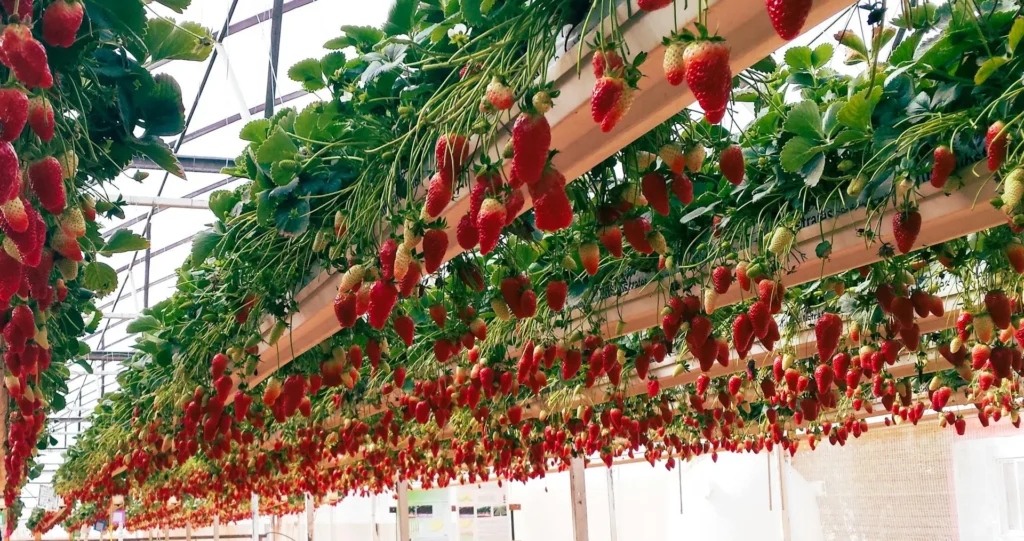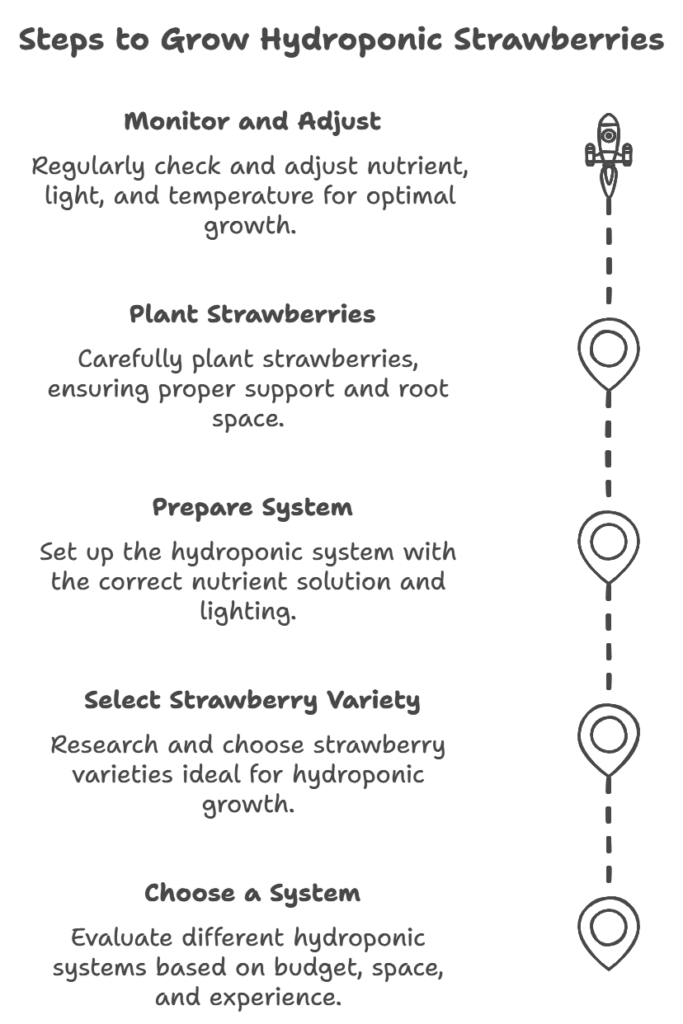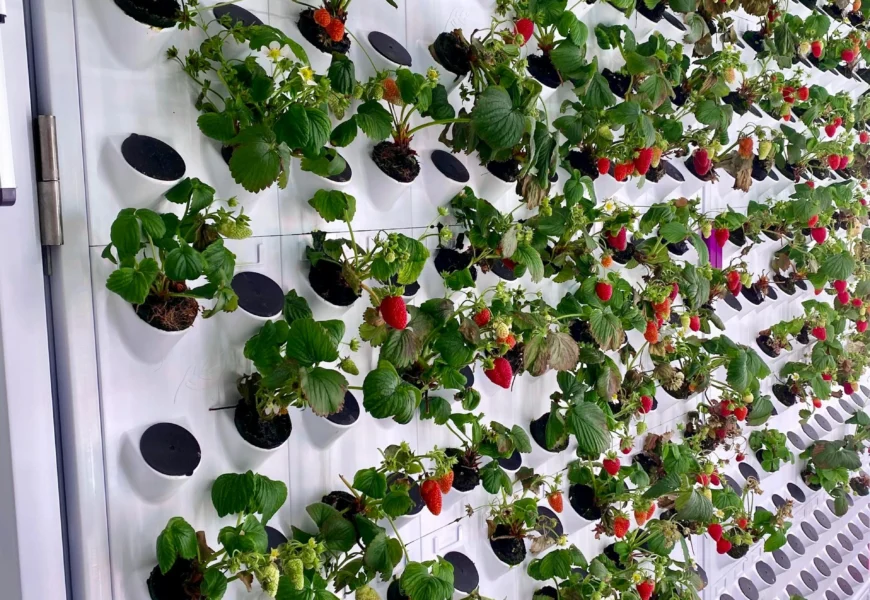The world of strawberry cultivation is bursting with innovation. While traditional soil-based methods remain popular, a new wave of farmers is turning to hydroponics to grow their luscious berries. But what are hydroponic strawberries?
Simply put, they’re strawberries grown without soil. Instead of relying on the earth, these delectable fruits thrive in a nutrient-rich water solution. It’s like giving your strawberries a personalized spa treatment, ensuring optimal growth and bountiful harvests.
Table of Contents:
1. What are hydroponic strawberries?
This shift towards hydroponics is driven by a desire for greater control and efficiency. Hydroponic strawberries are often grown indoors in carefully controlled environments. This allows growers to regulate factors like temperature, humidity, and lighting, creating ideal conditions for their plants to flourish. The result? Larger, sweeter strawberries, free from pesky soil-borne diseases, and a shorter harvest cycle compared to their soil-bound counterparts.
So, are you ready to dive into the exciting world of hydroponic strawberry farming? Let’s explore the advantages, techniques, and challenges involved in cultivating these water-loving wonders!
So, you’re curious about hydroponic strawberries? That’s awesome! Hydroponics is a fascinating way to grow plants, and strawberries are a particularly delicious and popular choice for this method. But what exactly are hydroponic strawberries?
Well, instead of growing in soil like traditional strawberries, hydroponic strawberries are cultivated in a nutrient-rich water solution. This means you can grow them indoors, year-round, with optimal control over their environment. Think of it like a fancy strawberry spa where every need is met, resulting in healthy, juicy berries.
2. What Makes Hydroponic Strawberries So Special?

Let’s break down some of the key advantages of growing strawberries hydroponically:
- Consistent Quality: Hydroponics allows for precise control over the water, nutrients, and temperature. This leads to consistent berry size, shape, and flavor, making for a truly delicious and reliable harvest.
- Increased Yield: Because hydroponic systems are optimized for growth, they often produce more strawberries per square foot compared to traditional methods. This can be a huge advantage for both home gardeners and commercial growers.
- Year-Round Harvest: Forget about waiting for the right season! Hydroponic strawberries can be grown indoors, independent of weather, allowing you to enjoy fresh berries year-round.
- Reduced Pest and Disease Problems: By controlling the environment, you can minimize the risk of pests and diseases that can affect traditional strawberry plants. This means less pesticide use and healthier berries for you.
- Environmental Benefits: Hydroponics can be more water-efficient than soil-based methods.
3. Getting Started with Hydroponic Strawberries
Want to try growing your own hydroponic strawberries? Here’s a simple guide to get you started:

- Choose a System: There are a variety of hydroponic systems available, ranging from simple DIY setups to more sophisticated commercial systems. Consider your budget, space, and experience level when choosing the right system for you.
- Select the Right Strawberry Variety: Not all strawberry varieties are created equal. Research different varieties to find those that are well-suited for hydroponic growing and produce delicious fruit.
- Prepare Your System: Follow the instructions for your chosen system, ensuring it is properly set up with the correct nutrient solution and lighting.
- Plant Your Strawberries: Gently plant your strawberry plants into the system, ensuring they are well-supported and have adequate root space.
- Monitor and Adjust: Like any plant, strawberries need regular monitoring to ensure they’re thriving. Adjust the nutrient solution, light, and temperature as needed to ensure optimal growth.
With a little patience and care, you’ll soon be enjoying delicious homegrown hydroponic strawberries!
Ready to take your hydroponic gardening to the next level? Check out our guide on how to create the perfect hydroponic environment.
For more information on the benefits of hydroponics and how to choose the right system for you, visit our post on hydroponic growing systems 101.
4. The Future of Strawberry Farming
What are hydroponic strawberries? They represent a promising future for the strawberry industry. By embracing hydroponics, growers can enhance efficiency, increase production, and provide consumers with fresh, high-quality strawberries year-round. This approach offers the potential for increased profitability, sustainability, and improved access to this delicious fruit for everyone.
If you’re interested in learning more about hydroponic strawberry production and the possibilities it offers, check out this comprehensive resource: The Ultimate Guide to Hydroponic Cannabis Cultivation.
Ready to take your strawberry farming to the next level? Explore the world of hydroponics and unlock the potential of these sweet treats!
5. The Benefits of Hydroponic Strawberries
So, now that we’ve covered the basics of what are hydroponic strawberries and how they’re grown, let’s dive into why they’re becoming increasingly popular. Hydroponic strawberry cultivation offers numerous advantages over traditional soil-based methods. Here are some key benefits:
1. Year-Round Production
One of the most significant advantages of hydroponics is the ability to grow strawberries year-round, regardless of the weather. By controlling the environment in a greenhouse or indoor setup, you can optimize growing conditions and ensure a consistent supply of fresh berries. This is especially beneficial for commercial growers who can supply supermarkets and consumers with strawberries even during the off-season.
2. Higher Yields
Hydroponic systems typically produce higher yields compared to traditional soil-based farming. This is due to several factors, including optimized nutrient delivery, reduced pest and disease pressure, and the ability to grow more plants in a smaller space. Higher yields translate to increased profitability for commercial growers.
3. Improved Quality
Hydroponically grown strawberries are often praised for their enhanced quality. By controlling the environment and nutrient intake, growers can produce berries that are larger, sweeter, and more flavorful. They also tend to have a longer shelf life due to reduced damage during harvesting and transportation.
4. Reduced Water Usage
While it might seem counterintuitive, hydroponic systems actually use less water than traditional farming. This is because the water is continuously circulated and reused, minimizing waste. In addition, the system allows for precise water delivery, ensuring that plants only receive the amount they need.
5. Sustainability
Hydroponics is often seen as a sustainable and environmentally friendly approach to agriculture. By minimizing the use of pesticides, herbicides, and fertilizers, it reduces the impact on the environment. The closed-loop system also reduces runoff and pollution, making it a more responsible way to grow food.
6. Less Labor Intensive
Hydroponic systems require less labor compared to traditional farming. This is because many tasks, such as watering and fertilizing, are automated. This can lead to reduced labor costs and increased efficiency for commercial growers.
7. Disease Resistance
Hydroponics offers a controlled environment that reduces the risk of pests and diseases. This means less reliance on chemical treatments and a safer, healthier product for consumers.
8. Urban Farming Potential
Hydroponic systems are well-suited for urban farming, as they can be easily adapted to grow in confined spaces. This makes it possible to produce fresh food in cities, even where traditional farming is not feasible.
9. Vertical Farming
Hydroponics enables vertical farming, which is the practice of growing crops in stacked layers. This innovative approach maximizes space and allows for increased production in a smaller footprint. Vertical farming is particularly useful for urban areas where land is limited.
10. Flexibility and Customization
One of the greatest benefits of hydroponic strawberry growing is the flexibility and customization it offers. You can adjust nutrient levels, lighting, and other factors to optimize growth and produce strawberries with specific characteristics. This opens up a world of possibilities for growers who want to experiment and create unique products.
What are hydroponic strawberries, you ask? They are simply strawberries grown in a nutrient-rich solution instead of soil. The benefits are undeniable, and as you’ve seen, hydroponic strawberry farming is revolutionizing the berry industry. Learn more about the exciting world of hydroponics and its potential to transform how we grow food!
Ready to learn more about growing your own hydroponic strawberries? Check out these articles for an in-depth guide on different hydroponic systems and techniques:
- The Ultimate Guide to Hydroponic Tower Gardens
- Hydroponic Growing System 101: How to Grow Your Own Food Without Soil
If you’re interested in learning more about building your own hydroponic strawberry system, check out our comprehensive guide on The Ultimate Guide to Hydroponic Tower Gardens.
Click & Grow indoor garden kit makes growing fresh herbs and veggies simple. Here's why it's perfect for you:
- Fresh Produce, Year-Round ☀️
- Easy to Use
- Perfect for Beginners
- Grow Anything You Like
Conclusion:
The future of strawberry farming looks bright with the rise of hydroponics. By embracing this innovative technology, growers can produce high-quality strawberries more efficiently, sustainably, and profitably.
As the demand for fresh, locally grown produce continues to grow, hydroponic strawberries are poised to become an integral part of the modern food system.
Whether you’re a seasoned grower or just starting your gardening journey, exploring the world of hydroponic strawberries could be a rewarding and delicious experience.












